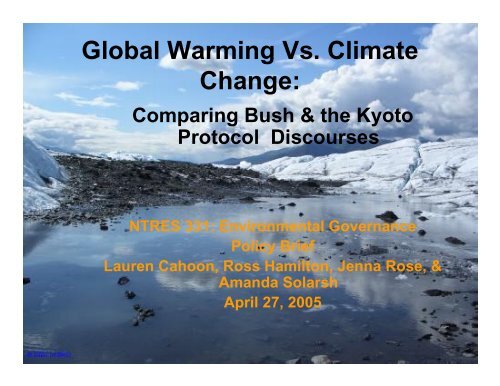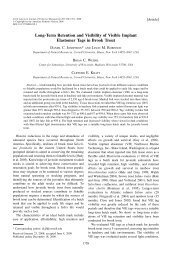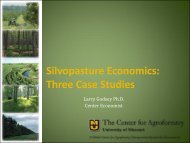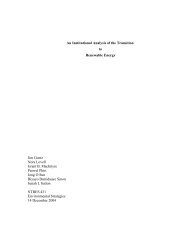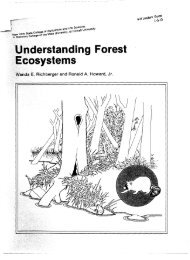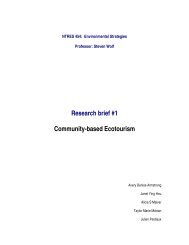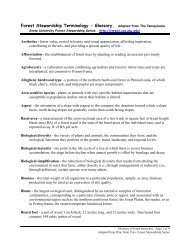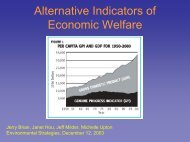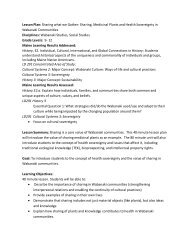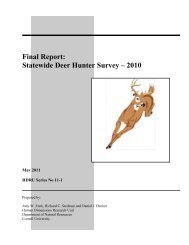Global Warming Vs. Climate Change: - Department of Natural ...
Global Warming Vs. Climate Change: - Department of Natural ...
Global Warming Vs. Climate Change: - Department of Natural ...
You also want an ePaper? Increase the reach of your titles
YUMPU automatically turns print PDFs into web optimized ePapers that Google loves.
<strong>Global</strong> <strong>Warming</strong> <strong>Vs</strong>. <strong>Climate</strong><br />
<strong>Change</strong>:<br />
Comparing Bush & the Kyoto<br />
Protocol Discourses<br />
NTRES 331: Environmental Governance<br />
Policy Brief<br />
Lauren Cahoon, Ross Hamilton, Jenna Rose, &<br />
Amanda Solarsh<br />
April 27, 2005
Background<br />
• The Kyoto Protocol: international<br />
treaty on global warming, as an<br />
amendment to the United Nations<br />
Framework Convention on <strong>Climate</strong><br />
<strong>Change</strong> (UNFCCC).<br />
• The developed countries commit<br />
themselves to reducing their collective<br />
emissions <strong>of</strong> six key greenhouse gases<br />
by at least 5%.<br />
• 141 countries have ratified the<br />
agreement.<br />
• Estimated to reduce average global<br />
temp. between 0.02˚C & 0.28˚C by<br />
2050.
History<br />
1972: 1 st Earth Summit in Stockholm:<br />
1988: International Panel on <strong>Climate</strong><br />
<strong>Change</strong> (IPCC) was started by the UN:<br />
1990: IPCC releases its 1 st report:<br />
1992: 2 nd <strong>of</strong>ficial Earth Summit in Rio de<br />
Janeiro, Brazil:<br />
1997: COP III in Kyoto, Japan:<br />
Current global environmental issues<br />
discussed, decided to meet every<br />
10 yrs.<br />
Brought together scientists from the<br />
world's governments to discuss<br />
whether the world was warming or<br />
cooling.<br />
It said it had reason to believe that the<br />
planet was warming, and that<br />
human activity was causing it.<br />
Largest gathering <strong>of</strong> world leaders ever<br />
and created the UNFCCC, also<br />
known as the Rio Convention.<br />
Where the protocol began. After<br />
reviewing the original targets <strong>of</strong> the<br />
Rio Convention and finding them to<br />
be too weak, the countries came up<br />
with new targets.
1998: Conference <strong>of</strong> the Parties<br />
IV, Bueno Aires, Argentina:<br />
2000: COP VI in The Hague,<br />
Netherlands:<br />
2001: COP VII in Bonn, Germany:<br />
2004: November: Russia Ratifies<br />
the Kyoto Protocol:<br />
2005: February: the Kyoto<br />
Protocol goes into effect.<br />
The Buenos Aires Plan <strong>of</strong> Action<br />
was developed to decide how<br />
the Kyoto mechanism would<br />
be implemented.<br />
Meeting failed due to an inability<br />
to agree on "carbon sinks," a<br />
key demand <strong>of</strong> both Canada<br />
and US.<br />
180 countries agreed to the rules<br />
for implementing the Kyoto<br />
Protocol, not US & Australia.<br />
55% <strong>of</strong> 1990 global greenhouse<br />
gas emissions min. reached so<br />
Protocol can go into effect.
Status Through M&K:<br />
• HEAVY Epoch I influence to date:<br />
Top down decision making and enforcement.<br />
“Command-and-control regulation” with<br />
predominantly remedial actions.<br />
• Epoch II elements are also present:<br />
<br />
<br />
Non-developed countries aren’t forced to comply<br />
Emissions trading permitted<br />
• Epoch III: Can we get there
Science behind global<br />
warming<br />
The facts:
What is the greenhouse effect<br />
<br />
<br />
<br />
Sunlight enters earth’s<br />
atmosphere, much <strong>of</strong><br />
it reflected back by<br />
earth’s surface.<br />
Greenhouse gases act<br />
as shield, trapping<br />
sun’s energy and<br />
preventing it from<br />
leaving the<br />
atmosphere<br />
Trapped sunlight<br />
causes earth’s surface<br />
and lower atmosphere<br />
temperatures to rise,<br />
changing weather and<br />
climate.
<strong>Change</strong>s in Greenhouse Gas Levels
What is changing<br />
<br />
1990’s was the warmest decade <strong>of</strong> the millennium<br />
<br />
<br />
20 th century was the warmest century <strong>of</strong> the millennium, with the<br />
global temperature rising by 1.4°F.<br />
At no point in the last 1,000 years has the earth’s temperature<br />
changed as rapidly as it has in the 20th century.
What’s causing the changes<br />
Burning <strong>of</strong> fossil fuels<br />
creates CO2<br />
<br />
Tropical deforestation eliminates<br />
crucial carbon sinks<br />
<br />
Refrigeration and air conditioning<br />
machinery creates CFC’s.<br />
<br />
Decomposition <strong>of</strong> waste, cattle<br />
farming creates methane
What’s going to happen<br />
<br />
The IPCC predicts that there will be an increase in temperature<br />
between 1.5-5.8°F by 2100<br />
CO2 could double its pre-industrial levels by 2080<br />
<br />
This warming could cause sea levels to rise up to 0.09-0.88 meters by<br />
the end <strong>of</strong> the century.<br />
Each 1° <strong>of</strong> global warming will shift temperature zones by about 100<br />
miles.<br />
<br />
By 2100, greenhouse gases would be double what they are now, and<br />
could result in either a quadrupling or a greater increase in greenhouse<br />
gases since the pre-industrial era.
The American Pro Kyoto<br />
Discourse:<br />
US Proponents for the Kyoto<br />
Protocol
Background<br />
• US Rejection <strong>of</strong> the Kyoto Protocol in 2001<br />
• Many businesses and states have started to<br />
take their own initiative in the reduction <strong>of</strong><br />
GHG emissions<br />
• US isolated for any international forum on<br />
global warming<br />
• <strong>Climate</strong> Stewardship Act<br />
Attempt by Senators McCain and<br />
Lieberman to implement cap and trade on<br />
GHG emissions opposed by Bush
Basic Entities<br />
• Serious problem/Immediate Action<br />
• Scientific certainty<br />
• International Cooperation<br />
• Top-down controls<br />
• Intrinsic value <strong>of</strong> nature
Assumptions About <strong>Natural</strong><br />
Relationships<br />
• Dependence on Nature<br />
• Technology and industry are the<br />
problem<br />
• Need strong regulations instituted by<br />
the government<br />
• Delaying action will cause more<br />
problems in the future
Major Actors/Motivation<br />
• Government Elites NOT BUSH!<br />
• Businesses/States<br />
• Countries/International Forum<br />
• US Responsibility
Metaphors/ Rhetorical Devices<br />
• International Problem<br />
• Team<br />
• Doomsday<br />
• <strong>Global</strong> <strong>Warming</strong><br />
• Cooperation
Similarities to Survivalist<br />
Discourse<br />
• Limits<br />
• Nature as its own entity<br />
• Technology is the problem<br />
• Top-down controls, strict<br />
• Urgency, action now<br />
• General Population
Similarities to Administrative<br />
Rationalism<br />
• Power <strong>of</strong> Elites<br />
• Based on expert science<br />
• Top-down control<br />
• Create legislation based on a “unified”<br />
opinion from the public<br />
Doesn’t take into account all<br />
stakeholders
Criticisms <strong>of</strong> Kyoto<br />
• Unfair, allows developing countries to pollute<br />
more, i.e. China and India<br />
• The effects <strong>of</strong> global warming are uncertain;<br />
limits are not scientifically proven<br />
• Costly to American economy<br />
• Other proposals are better for American<br />
economy<br />
• Unfairly targets certain industry sectors<br />
• Kyoto is flawed so why should the US be<br />
apart <strong>of</strong> it
The Bush Administration<br />
Discourse
Background<br />
• February 2002- Bush unveils plan to confront climate<br />
change<br />
• Plans to reduce Greenhouse Gas Intensity <strong>of</strong> the US<br />
economy by 18% in 10 years.<br />
• Creates Cabinet Committee<br />
• Funding for climate change activities<br />
• Tax incentives to reduce greenhouse gas emissions<br />
• International Cooperation: multilateral and bilateral<br />
agreements
Basic Entities<br />
• Industry<br />
• Government Agencies<br />
• Scientific Uncertainty<br />
• Technology and Innovation<br />
• (no natural entities, such as biodiversity,<br />
ecosystems, biosphere)
Assumptions about <strong>Natural</strong><br />
Relationships<br />
• Economic Growth Environmental Progress<br />
• Funding and research Green Technologies<br />
• Human need Human Innovation<br />
• Beneficial Competition<br />
• (no dependence or interdependence on<br />
natural systems)
Major Actors and Motivations<br />
• Industry and the Market<br />
• Government<br />
• Developing Countries<br />
• (No motivations beyond economic interest)<br />
• (No role for the government as a protector <strong>of</strong><br />
non-economic goods)<br />
• (Only scientific certainty can motivate action)
Key Metaphors and Rhetorical Devices<br />
• Militaristic Use <strong>of</strong> Force<br />
• Common sense<br />
• <strong>Global</strong> Participation<br />
• <strong>Climate</strong> <strong>Change</strong>
Similarities to the Promethean<br />
Discourse<br />
• Technology<br />
• Human innovation<br />
• <strong>Natural</strong> resources as brute matter<br />
• Power <strong>of</strong> the free market<br />
• Rationalistic pursuit <strong>of</strong> self-interest<br />
• No acknowledgement <strong>of</strong> natural limits
Similarities to Economic Rationalism<br />
• Reliance on the market<br />
• Small emphasis on the role <strong>of</strong> the state<br />
• Importance <strong>of</strong> competition
Criticisms<br />
• Scientific uncertainty<br />
• Economic impact<br />
• Need for Regulatory not Voluntary Action<br />
• Alienates global community
The Greenhouse Network<br />
Discourse: Epoch III<br />
• Basic entities: all stakeholders: community, state and market<br />
• Assumptions about natural relationships: recognize a mutual<br />
dependence between humans and nature, both nature and human<br />
well-being recognized as having inherent value, technology and<br />
industry viewed as both positive and negative potential.<br />
• Major actors, motivations: Community, state and market. Each<br />
has different motivations (market: self-interest, state: watchdog,<br />
communities: social, cultural values). Both “under-socialized” and<br />
“over-socialized” motivations driving individuals.<br />
• Metaphors, Rhetoric: Greenhouse, Stern et al.’s “tree”,<br />
interconnectedness between nature and humans,
State<br />
• State: establishes framework and objectives for<br />
emission reduction, provides positive and negative<br />
reinforcement<br />
Example: State mandates that all coal industries must reduce<br />
emissions by 10% in 5 years.<br />
If a whole industry goes over this limit, individual firms are taxed per<br />
ton, if companies reduce more than required, they are given<br />
financial rewards.<br />
State funds creation <strong>of</strong>/ gives decision-making power to Greenhouse<br />
Gas Planning Organizations (GPO’s), as well as green<br />
technology development in Universities and businesses.
Market<br />
• Industry leaders collaborate to reach<br />
consensus on a mechanism to achieve state<br />
objectives, incentives provided by state<br />
cause willing cooperation:<br />
• Example: Coal industry decides to implement a ‘cap<br />
and trade’ market to comply with state’s requirements<br />
• Industries use marketing, public relations to advertise<br />
their progressive green efforts to appeal to<br />
customers.<br />
• “Survival <strong>of</strong> the Fittest” will weed out industries that<br />
fail to comply with State’s mandates (taxation,<br />
financial loss)<br />
• Growth in green sector gives US a comparative<br />
advantage with other countries and creates desirable<br />
job opportunities.
Community<br />
• Community: given responsibility <strong>of</strong><br />
enacting local goals via trial and<br />
error as well as democratic<br />
pragmatism, in particular, promoting<br />
greener techniques in housing and<br />
transportation<br />
• Example: State gives GPOs money<br />
to implement green solutions, i.e.,<br />
solar power initiative. This success<br />
will spur similar initiatives in other<br />
communities<br />
• Zoning for green buildings, parking<br />
for smart cars, buying clubs for green<br />
products<br />
• Real world example: Pittsburgh.
Networks<br />
• Networks: local organizations, (GROs, NGOs) given<br />
power from community, legitimization from state,<br />
strengthen social capital within community<br />
• Example: Same as previous example (GPOs)<br />
• Government agency that provides network for<br />
unemployed to access new jobs in the green sector<br />
• Promote successful local initiatives in other<br />
communities, ‘learning’ between communities.
Questions


